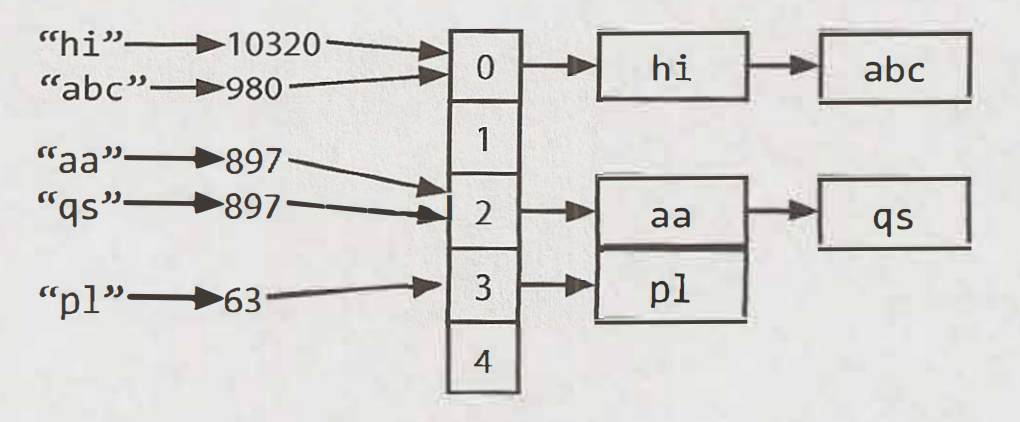雜湊表 (Hash Tables)
雜湊表是對應鍵(key)與值(value),以供高效率查詢的資料結構。
以下描述簡單但最常見的實作。
我們使用一個鏈接清單(linked list)陣列與一個雜湊編碼函式(hash code function)。
當要插入鍵與值時,我們會執行:
- 首先計算鍵的雜湊編碼,通常為int或long。
注意兩個不同的鍵可能有相同的雜湊編碼。
- 對應該雜湊編碼到陣列的一個索引(index)。
它可以是hash(key)% array_length。
兩個不同的雜湊編碼可能對應到同一個索引。
- 此索引有個鍵與值的鏈接清單。將鍵與值存在這個索引中。
我們必須使用鏈接清單是因為有衝突(collision):
兩個不同的鍵具有相同的雜湊編碼,或不同的雜湊編碼對應到相同索引。
若衝突量很高,最差的執行時間是$O(n)$,N為鍵的數量。
但好的實作可以將衝突降至最少,此時的查詢時間為$O(1)$。

另外我們也可以用平衡二元搜尋樹(balanced binary search tree)實作雜湊表。
它具有$O(logN)$查詢時間。好處是使用較少空間,因為不需要分配(allocate)大陣列。
還能夠依序迭代(iterate)所有鍵,在某些情況很實用。
Binary Search Tree(BST):
- Key(L)<Key(Current)<Key(R)
- Both subtrees of each node are also BSTs
Balanced Binary Search Tree:
- A binary search tree in which the left and right subtrees of every node differ in height by no more than 1
ArrayList 與可變大小陣列
有些語言的陣列可以自動調整大小 (通常稱為清單)。
Java等其他語言的陣列大小是固定的。
你需要可動態調整大小的類陣列結構時,通常可使用ArrayList。
ArrayList是自行調整大小的陣列但存取還是$O(1)$。
典型的實作會在陣列滿時,加倍大小。
每次加倍需要$O(n)$時間,但很少發生,插入時間平攤後還是$O(1)$。
1 | ArrayList<String> merge(String[] words, String[] more) { |
為什麼分攤後的插入時間是$O(1)$?
參考先前的平攤時間。
StringBuilder
假設要如下連接字串清單,這段程式的執行時間是什麼?
假設字串的長度(x)都相等且有n個字串。
1 | String joinWords(String[] words) { |
每個連接都產生新的字串拷貝,將兩個字串複製並連接在一起。
第一個迭代需要複製x個字元、第二個迭代需要複製2x個字元、…
因此總時間為$O(x+2x+…+nx) = O(xn^2)$
(因為$1+2+…+n = n(n+1)/2$)
StringBuilder可以避免這個問題。
StringBuilder建構可調整大小的陣列,只在有需要時再複製成字串。
1 | String joinWords(String[] words) { |
面試題目
1.1 Is Unique
Implement an algorithm to determine if a string has all unique characters. What if you cannot use additional data structures?
先詢問字串是ASCII或Unicode。
補充:
ASCII (American Standard Code for Information Interchange,美國標準資訊交換碼)
用一個位元組(bite),即8個位元(bit),來表示一個字元。
位元組的最高位統一規定為0,剩餘7位用來存儲數據。共128種編碼。
擴展的ASCII編碼,則是把位元組的最高位原本統一設置為0的,也用來存儲字符數據。
但各國在擴展的部分定義不同。共256種編碼。Unicode,又被稱為統一碼、萬國碼,使用兩個位元組,即16位元來表示字元。
UTF-8 (8-bit Unicode Transformation Format),是Unicode的一種編碼方式。
可以用一至四個位元組對Unicode字元集中的所有有效編碼點進行編碼。為解決向下相容ASCII碼而設計。
假設為ASCII的128個字元。
1 | public static function isUnique($string): bool |
此程式的時間複雜度為$O(n)$,n為字串長度。
空間複雜度為$O(1)$。
也可以說時間複雜度為$O(1)$,因為不會迭代超過128個字元。
若不想假設字元集的大小,可以說時間複雜度為$O(min(c,n))$。
其中c為字元集的大小。
提示:使用位元向量。
使用位元向量可降低使用空間。
假設字串只使用a到z的小寫字母。
1 | public static function isUnique($string): bool |
若不能使用其他資料結構呢?
相互比較字串的每個字元,需要$O(n^2)$的時間與$O(1)$空間。
若可以修改字元,我們可以用$O(nlog(n))$時間將字串排序,
然後線性檢查相鄰字元是否相同。
注意:許多排序演算法需要額外空間。
1.5 One Away
There are three types of edits that can be performed on strings: Insert a character, remove a character, or replace a character. Given two strings, write a function to check if they are one edit (or zero edits) away.
[Example]
pale, ple -> true
pales, pale -> true
pale, bale -> true
pale, bake -> false
1 | public static function isOneOrZeroAway(string $string1, string $string2): bool |
1.9 String Rotation
Assume you have a method isSubstring which checks if oneword is a substring of another. Given two strings, sl and s2, write code to check if s2 is a rotation of sl using only one call to isSubstring.
(e.g. “waterbottle” is a rotation of”erbottlewat”)
First Answer:
1 | public static function isRotation($string1, $string2): bool |
Best Answer:
1 | public static function isRotation($string1, $string2): bool |
ʕ •ᴥ•ʔ:程式碼可參考:CtCI-6th-php。